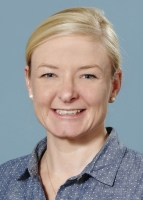Head and neck cancer
Head and neck cancer arises in the head or neck region (in the nasal cavity, sinuses, lips, mouth, salivary glands, throat, or larynx (voice box).
The UC Davis Comprehensive Cancer Center relies on multidisciplinary teams of top academic physicians in the diagnosis and treatment of head and neck cancers.
The surgical team includes otolaryngologists/head and neck surgeons, otologists, neurosurgeons, plastic and reconstructive surgeons, prosthodontists, neuroradiologists and pathologists. Treatment plans are coordinated with medical and radiation oncologists.
The UC Davis Department of Radiation Oncology provides a number of unique treatment modalities for head and neck cancer. The faculty, physicians and physicists responsible for treatment programs and planning for individual patients are experts in their fields.

The following tests and procedures may be used to diagnose or stage laryngeal cancer:
Physical exam of the throat and neck: An examination in which the doctor feels for swollen lymph nodes in the neck and looks down the throat with a small, long-handled mirror to check for abnormal areas.
Ultrasound: A non-invasive imaging procedure, which uses sound waves to create a high-quality picture of the throat and neck, as well as to detect enlarged lymph nodes.
Laryngoscopy: A procedure in which the doctor examines the larynx (voice box) with a mirror or with a laryngoscope (a thin, lighted tube).
Endoscopy: A procedure to look at organs and tissues inside the body to check for abnormal areas. An endoscope (a thin, lighted tube) is inserted through an incision (cut) in the skin or opening in the body, such as the mouth. Tissue samples and lymph nodes may be taken for biopsy.
CT scan (CAT scan- computerized axial tomography): A procedure that makes a series of detailed pictures of areas inside the body, taken from different angles. The pictures are made by a computer linked to an x-ray machine. A dye may be injected into a vein or swallowed to help the organs or tissues show up more clearly. This procedure is also called computed tomography, computerized tomography, or computerized axial tomography.
MRI (magnetic resonance imaging): A procedure that uses a magnet, radio waves, and a computer to make a series of detailed pictures of areas inside the body. This procedure is also called nuclear magnetic resonance imaging (NMRI).
Biopsy: The removal of cells or tissues so they can be viewed under a microscope to check for signs of cancer. An ultrasound is often used to help guide the surgeon’s instruments to the site of the abnormal growth.
Barium swallow: A series of x-rays of the esophagus and stomach. The patient drinks a liquid that contains barium (a silver-white metallic compound). The liquid coats the esophagus and stomach, and x-rays are taken. This procedure is also called an upper GI series.
The following tests may be used to diagnose or stage oral cavity cancer:
Physical exam of the lips and oral cavity: An exam to check the lips and oral cavity for abnormal areas. The doctor or dentist will feel the entire inside of the mouth with a gloved finger and examine the oral cavity with a small long-handled mirror and lights. This will include checking the insides of the cheeks and lips; the gums; the roof and floor of the mouth; and the top, bottom, and sides of the tongue. The neck will be felt for swollen lymph nodes. A history of the patient’s health habits and past illnesses and medical and dental treatments will also be taken.
Ultrasound: A non-invasive imaging procedure, which uses sound waves to create a high-quality picture of the throat and neck, as well as to detect enlarged lymph nodes.
Endoscopy: A procedure to look at organs and tissues inside the body to check for abnormal areas. An endoscope is inserted through an incision (cut) in the skin or opening in the body, such as the mouth. An endoscope is a thin, tube-like instrument with a light and a lens for viewing. It may also have a tool to remove tissue or lymph node samples, which are checked under a microscope for signs of disease.
X-rays of the head, neck, and chest: An x-ray is a type of energy beam that can go through the body and onto film, making a picture of areas inside the body.
Biopsy: The removal of cells or tissues so they can be viewed under a microscope by a pathologist. If leukoplakia is found, cells taken from the patches are also checked under the microscope for signs of cancer. An ultrasound is often used to help guide the surgeon’s instruments to the site of the abnormal growth.
MRI (magnetic resonance imaging): A procedure that uses a magnet, radio waves, and a computer to make a series of detailed pictures of areas inside the body. This procedure is also called nuclear magnetic resonance imaging (NMRI).
CT scan (CAT scan- computerized axial tomography): A procedure that makes a series of detailed pictures of areas inside the body, taken from different angles. The pictures are made by a computer linked to an x-ray machine. A dye may be injected into a vein or swallowed to help the organs or tissues show up more clearly. This procedure is also called computed tomography, computerized tomography, or computerized axial tomography.
Exfoliative cytology: A procedure to collect cells from the lip or oral cavity. A piece of cotton, a brush, or a small wooden stick is used to gently scrape cells from the lips, tongue, mouth, or throat. The cells are viewed under a microscope to find out if they are abnormal.
Barium swallow: A series of x-rays of the esophagus and stomach. The patient drinks a liquid that contains barium (a silver-white metallic compound ). The liquid coats the esophagus and x-rays are taken. This procedure is also called an upper GI series.
PET scan (positron emission tomography scan): A procedure to find malignant tumor cells in the body. A small amount of radionuclide glucose (sugar) is injected into a vein. The PET scanner rotates around the body and makes a picture of where glucose is being used in the body. Malignant tumor cells show up brighter in the picture because they are more active and take up more glucose than normal cells do.
The following tests may be used to diagnose or stage oropharyngeal cancer:
Physical exam and history: An exam of the body to check general signs of health, including checking for signs of disease, such as swollen lymph nodes in the neck or anything else that seems unusual. The doctor does a complete exam of the mouth and neck and looks down the throat with a small, long-handled mirror to check for abnormal areas. A history of the patient’s health habits and past illnesses and treatments will also be taken.
Ultrasound: A non-invasive imaging procedure, which uses sound waves to create a high-quality picture of the throat and neck, as well as to detect enlarged lymph nodes.
CT scan (CAT scan- computerized axial tomography): A procedure that makes a series of detailed pictures of areas inside the body, taken from different angles. The pictures are made by a computer linked to an x-ray machine. A dye may be injected into a vein or swallowed to help the organs or tissues show up more clearly. This procedure is also called computed tomography, computerized tomography, or computerized axial tomography.<
MRI (magnetic resonance imaging): A procedure that uses a magnet, radio waves, and a computer to make a series of detailed pictures of areas inside the body. This procedure is also called nuclear magnetic resonance imaging (NMRI).
X-rays: An x-ray of the organs and bones. An x-ray is a type of energy beam that can go through the body and onto film, making pictures of areas inside the body.
PET scan (positron emission tomography scan): A procedure to find malignant tumor cells in the body. A small amount of radionuclide glucose (sugar) is injected into a vein. The PET scanner rotates around the body and makes a picture of where glucose is being used in the body. Malignant tumor cells show up brighter in the picture because they are more active and take up more glucose than normal cells do.
Endoscopy: A procedure to look at organs and tissues inside the body to check for abnormal areas. An endoscope is inserted through the patient’s nose or mouth to look at areas in the throat that cannot be seen during a physical exam of the throat. An endoscope is a thin, tube-like instrument with a light and a lens for viewing. It may also have a tool to remove tissue or lymph node samples, which are checked under a microscope for signs of disease.
Biopsy: The removal of cells or tissues so they can be viewed under a microscope by a pathologist to check for signs of cancer. An ultrasound is often used to help guide the surgeon’s instruments to the site of the abnormal growth.
Sources: National Cancer Institute and UC Davis Comprehensive Cancer Center
Laryngeal cancer
- A sore throat or cough that does not go away
- Trouble or pain when swallowing
- Ear pain
- A lump in the neck or throat
- A change or hoarseness in the voice
Oral cavity cancer
- A sore on the lip or in the mouth that does not heal
- A lump or thickening on the lips or gums or in the mouth
- A white or red patch on the gums, tongue, tonsils, or lining of the mouth
- Bleeding, pain, or numbness in the lip or mouth
- Change in voice
- Loose teeth or dentures that no longer fit well
- Trouble chewing or swallowing or moving the tongue or jaw
- Swelling of jaw
- Sore throat or feeling that something is caught in the throat
Oropharyngeal cancer
- A sore throat that does not go away
- A dull pain behind the breastbone
- Cough
- Trouble swallowing
- Weight loss for no known reason
- Ear pain
- A lump in the back of the mouth, throat, or neck
- A change in voice
Sources: National Cancer Institute and UC Davis Comprehensive Cancer Center
Use of tobacco products and drinking too much alcohol can affect the risk of developing laryngeal cancer, oral cavity cancer and oropharyngeal cancer.
Other risk factors for oral cavity cancer include:
- Being exposed to natural sunlight or artificial sunlight (such as from tanning beds) over long periods of time
- Being male
- Being infected with human papillomavirus (HPV)
Other risk factors for oropharyngeal include:
- A diet low in fruits and vegetables
- Drinking maté, a stimulant drink common in South America
- Chewing betel quid, a stimulant commonly used in parts of Asia
- Being infected with human papillomavirus (HPV)
Sources: National Cancer Institute and UC Davis Comprehensive Cancer Center
Laryngeal cancer
Radiation therapy
Radiation therapy is a cancer treatment that uses high-energy x-rays or other types of radiation to kill cancer cells. There are two types of radiation therapy. External radiation therapy uses a machine outside the body to send radiation toward the cancer. Internal radiation therapy uses a radioactive substance sealed in needles, seeds, wires, or catheters that are placed directly into or near the cancer. The way the radiation therapy is given depends on the type and stage of the cancer being treated.
Radiation therapy may work better in patients who have stopped smoking before beginning treatment. External radiation therapy to the thyroid or the pituitary gland may change the way the thyroid gland works. The doctor may test the thyroid gland before and after therapy to make sure it is working properly.
Surgery
Surgery (removing the cancer in an operation) is a common treatment for all stages of laryngeal cancer. The UC Davis Center for Skull Base Surgery, the largest program of its kind in the Western United States, has established an international reputation for excellence in the treatment of head and neck tumors. The center employs the most advanced technologies available, from highly focused laser tools to powerful operating microscopes.
Our surgeons use the latest surgical innovations to operate more precisely, make smaller incisions and preserve the patient’s quality of life. Transoral robotic surgery, a minimally invasive technique allows our surgeons to excise the cancer while maintaining the patient’s ability to eat, speak and live a normal life. With extensive training in microvascular surgery, one of the most advanced surgical options available in reconstructive surgery, our specialists transplant tissue from other parts of the body to reconstruct the missing bone and other tissues that are removed during surgery.
The following surgical procedures may be used:
- Cordectomy: Surgery to remove the vocal cords only.
- Supraglottic laryngectomy: Surgery to remove the supraglottis only.
- Hemilaryngectomy: Surgery to remove half of the larynx (voice box). A hemilaryngectomy saves the voice.
- Partial laryngectomy: Surgery to remove part of the larynx (voice box). A partial laryngectomy helps keep the patient's ability to talk.
- Total laryngectomy: Surgery to remove the whole larynx. During this operation, a hole is made in the front of the neck to allow the patient to breathe. This is called a tracheostomy.
- Thyroidectomy: The removal of all or part of the thyroid gland.
- Laser surgery: A surgical procedure that uses a laser beam (a narrow beam of intense light) as a knife to make bloodless cuts in tissue or to remove a surface lesion such as a tumor.
Even if the doctor removes all the cancer that can be seen at the time of the surgery, some patients may be given chemotherapy or radiation therapy after surgery to kill any cancer cells that are left. Treatment given after the surgery, to lower the risk that the cancer will come back, is called adjuvant therapy.
More about surgical interventions for head and neck cancer
Chemotherapy
Chemotherapy is a cancer treatment that uses drugs to stop the growth of cancer cells, either by killing the cells or by stopping the cells from dividing. When chemotherapy is taken by mouth or injected into a vein or muscle, the drugs enter the bloodstream and can reach cancer cells throughout the body (systemic chemotherapy). When chemotherapy is placed directly into the spinal column, an organ, or a body cavity such as the abdomen, the drugs mainly affect cancer cells in those areas (regional chemotherapy). The way the chemotherapy is given depends on the type and stage of the cancer being treated.
Oral cavity cancer
Surgery
Surgery (removing the cancer in an operation) is a common treatment for all stages of lip and oral cavity cancer. The UC Davis Center for Skull Base Surgery, the largest program of its kind in the Western United States, has established an international reputation for excellence in the treatment of head and neck tumors. The center employs the most advanced technologies available, from highly focused laser tools to powerful operating microscopes.
Our surgeons use the latest surgical innovations to operate more precisely, make smaller incisions and preserve the patient’s quality of life. Transoral robotic surgery, a minimally invasive technique, allows our surgeons to excise the cancer while maintaining the patient’s ability to eat, speak and live a normal life.
Surgery may include the following:
- Wide local excision: Removal of the cancer and some of the healthy tissue around it. If cancer has spread into bone, surgery may include removal of the involved bone tissue.
- Neck dissection: Removal of lymph nodes and other tissues in the neck. This is done when cancer may have spread from the lip and oral cavity.
Plastic surgery : An operation that restores or improves the appearance of parts of the body. Dental implants, a skin graft, or other plastic surgery may be needed to repair parts of the mouth, throat or neck. With extensive training in microvascular surgery, one of the most advanced surgical options available in reconstructive surgery, our specialists transplant tissue from other parts of the body to reconstruct the missing bone and other tissues that are removed during surgery.
Even if the doctor removes all the cancer that can be seen at the time of the surgery, some patients may be given chemotherapy or radiation therapy after surgery to kill any cancer cells that are left. Treatment given after the surgery, to lower the risk that the cancer will come back, is called adjuvant therapy.
Radiation therapy
Radiation therapy is a cancer treatment that uses high-energy x-rays or other types of radiation to kill cancer cells. There are two types of radiation therapy. External radiation therapy uses a machine outside the body to send radiation toward the cancer. Internal radiation therapy uses a radioactive substance sealed in needles, seeds, wires, or catheters that are placed directly into or near the cancer. The way the radiation therapy is given depends on the type and stage of the cancer being treated.
For patients who smoke, radiation therapy works better when smoking is stopped before beginning treatment. It is also important for patients to have a dental exam before radiation therapy begins, so that existing problems can be treated.
Oropharyngeal cancer
Surgery
Surgery (removing the cancer in an operation) is a common treatment of all stages of oropharyngeal cancer. The UC Davis Center for Skull Base Surgery, the largest program of its kind in the Western United States, has established an international reputation for excellence in the treatment of head and neck tumors. The center employs the most advanced technologies available, from highly focused laser tools to powerful operating microscopes.
Our surgeons use the latest surgical innovations to operate more precisely, make smaller incisions and preserve the patient’s quality of life. Transoral robotic surgery, a minimally invasive technique, allows our surgeons to excise the cancer while maintaining the patient’s ability to eat, speak and live a normal life. With extensive training in microvascular surgery, one of the most advanced surgical options available in reconstructive surgery, our specialists transplant tissue from other parts of the body to reconstruct the missing bone and other tissues that are removed during surgery.
Even if the doctor removes all the cancer that can be seen at the time of the surgery, some patients may be given chemotherapy or radiation therapy after surgery to kill any cancer cells that are left. Treatment given after the surgery, to lower the risk that the cancer will come back, is called adjuvant therapy.
Radiation therapy
Radiation therapy is a cancer treatment that uses high-energy x-rays or other types of radiation to kill cancer cells. There are two types of radiation therapy. External radiation therapy uses a machine outside the body to send radiation toward the cancer. Internal radiation therapy uses a radioactive substance sealed in needles, seeds, wires, or catheters that are placed directly into or near the cancer. The way the radiation therapy is given depends on the type and stage of the cancer being treated. Fractionated radiation therapy divides the total dose of radiation therapy into several smaller, equal doses given over several days.
Radiation therapy may be more effective in patients who have stopped smoking before beginning treatment.
Radiation therapy to the thyroid or pituitary gland increases the risk of hypothyroidism (too little thyroid hormone). Thyroid function tests should be done before and after treatment.
Sources: National Cancer Institute and UC Davis Comprehensive Cancer Center
Otolaryngology / Head and Neck Surgery
 Marianne Abouyared, M.D.
Marianne Abouyared, M.D.
Assistant Professor of Otolaryngology
Head and Neck Oncology and Microvascular Surgery
 Peter C. Belafsky, M.D., M.P.H., Ph.D.
Peter C. Belafsky, M.D., M.P.H., Ph.D.
Professor of Otolaryngology
Director, Center for Voice and Swallowing
 Arnaud F. Bewley, M.D.
Arnaud F. Bewley, M.D.
Chair and Associate Professor of Otolaryngology
Head and Neck Oncology and Microvascular Surgery
 Andrew Birkeland, M.D.
Andrew Birkeland, M.D.
Assistant Professor of Otolaryngology
Head and Neck Oncology and Microvascular Surgery
 Daniel J. Cates, M.D.
Daniel J. Cates, M.D.
Assistant Professor of Otolaryngology
![]() Rodney C. Diaz, M.D., F.A.C.S.
Rodney C. Diaz, M.D., F.A.C.S.
Professor of Neurological Surgery
 Scott Fuller, M.D., M.Sc.
Scott Fuller, M.D., M.Sc.
Clinical Associate Professor of Otolaryngology
 Maggie A. Kuhn, M.D., M.A.S.
Maggie A. Kuhn, M.D., M.A.S.
Associate Professor of Otolaryngology
Medical Director, Center for Voice and Swallowing
 Doron Sagiv, M.D.
Doron Sagiv, M.D.
Assistant Clinical Professor of Neurological Surgery
 Toby O. Steele, M.D.
Toby O. Steele, M.D.
Associate Professor of Neurological Surgery
 E. Bradley Strong, M.D.
E. Bradley Strong, M.D.
Professor of Neurological Surgery
 Jennifer Stein, M.S., R.N., C.C.R.N., F.N.P.-B.C.
Jennifer Stein, M.S., R.N., C.C.R.N., F.N.P.-B.C.
Hematology and Oncology
 Helen K. Chew, M.D.
Helen K. Chew, M.D.
Vice Chief Hematology and Oncology, Professor Internal Medicine, Hematology and Oncology
 Jonathan Riess, M.D., M.S.
Jonathan Riess, M.D., M.S.
Associate Professor Internal Medicine, Hematology and Oncology
Neuroradiology
 Matthew Bobinski, M.D.,Ph.D.
Matthew Bobinski, M.D.,Ph.D.
Professor of Radiology and Chief of Neuroradiology
 Arzu Ozturk, M.D.
Arzu Ozturk, M.D.
Associate Professor, Division of Neuroradiology
 Osama Anwar Ahmed Raslan, M.D., M.Sc., M.B.B.Ch.
Osama Anwar Ahmed Raslan, M.D., M.Sc., M.B.B.Ch.
Assistant Professor, Division of Neuroradiology
![]() Maryam Shahrzad, M.D.
Maryam Shahrzad, M.D.
Assistant Professor, Division of Neuroradiology
Neurological Surgery
 Orwa Aboud, M.D., Ph.D.
Orwa Aboud, M.D., Ph.D.
Assistant Professor of Neurology and Neurological Surgery
 Orin Bloch, M.D., FAANS
Orin Bloch, M.D., FAANS
Director, UC Davis Brain Tumor Program
Professor of Neurological Surgery
 Kiarash Shahlaie, M.D., Ph.D., FAANS
Kiarash Shahlaie, M.D., Ph.D., FAANS
Professor of Neurological Surgery
Interim Chair, Department of Neurosurgery
Nuclear Medicine
 Fatma Sen, M.D., M.Sc.
Fatma Sen, M.D., M.Sc.
Associate Clinical Professor, Division of Nuclear Medicine
Pathology
 Morgan Angus Darrow, M.D.
Morgan Angus Darrow, M.D.
Assistant Professor of Pathology
 Han Sung Lee, M.D., Ph.D.
Han Sung Lee, M.D., Ph.D.
Associate Professor of Pathology
Radiation Oncology
 Megan Daly, M.D.
Megan Daly, M.D.
Professor
 Shyam Rao, M.D., Ph.D.
Shyam Rao, M.D., Ph.D.
Associate Professor
Dentistry
 William John Love, D.D.S.
William John Love, D.D.S.
Director of Dental Services
Speech Pathology
 Lisa Marie Evangelista, CSc.D., C.C.C.-S.L.P., B.C.S.-S.
Lisa Marie Evangelista, CSc.D., C.C.C.-S.L.P., B.C.S.-S.
Director, Speech-Language Pathology
![]() Leia Chapman, M.S., C.C.C.-S.L.P.
Leia Chapman, M.S., C.C.C.-S.L.P.
Speech-Language Pathologist
Dietitians
 Danielle Baham, M.S., R.D.
Danielle Baham, M.S., R.D.
 Kathryn MacLean, M.S., R.D.
Kathryn MacLean, M.S., R.D.
 Jaime Tucker, R.D.
Jaime Tucker, R.D.
Genetic Counselors
Social Workers
 Anna Alper, L.C.S.W.
Anna Alper, L.C.S.W.
 Sara Chavez, L.C.S.W., O.S.W.-C., A.C.H.P.-S.W.
Sara Chavez, L.C.S.W., O.S.W.-C., A.C.H.P.-S.W.
 Sarah Conning, L.C.S.W., O.S.W.-C.
Sarah Conning, L.C.S.W., O.S.W.-C.





 Beverly Garber, A.N.P.-C
Beverly Garber, A.N.P.-C
 Nicole Mans, M.S., L.C.G.C.
Nicole Mans, M.S., L.C.G.C. Jeanna Welborn, M.D.
Jeanna Welborn, M.D.